There is no need to look further than your own garden for the best Christmas greenery to use for holiday decorating. Right outside your door, growing in your garden, neighbourhoods, and parks are filled with shrubs, trees, and perennial plants that would be very happy to share a few branches with you for seasonal enjoyment.
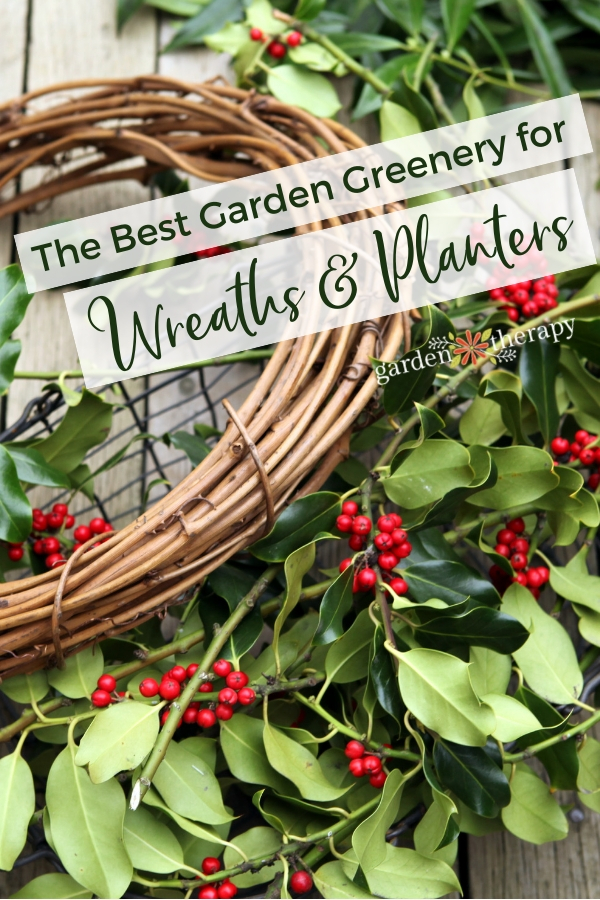
When it comes to decorating for Christmas, I always fill my house with tons of foraged greenery. I take bits from my garden, neighbourhood, and local nature areas to bring the outdoors inside. It’s the easiest, cheapest, and most beautiful way to decorate for Christmas in my opinion!
This will guide you through some of the best types of greenery for Christmas based on appearance and longevity and also which ones you should avoid.
Jump ahead to…
- How to Responsibly Prune Christmas Greenery
- Types of Greenery for Holiday Decorating
- Conifers
- Broad-Leaf Evergreens
- Herbs
- Perennials and Flowers
- Branches
- Types of Greenery to Avoid
- Frequently Asked Questions About Decorating With Christmas Greenery
- How to Use Christmas Greenery
How to Responsibly Prune Christmas Greenery
First a note on pruning! When harvesting greenery for Christmas, it’s important to follow the basics of pruning to maintain the plant’s overall health.
Take care to remove branches from trees and shrubs as if you were thinning the structure. This will help to retain the beauty of the plant in the landscape. Perennials that have dried in the garden can be cut back completely without any issues.
My Favourite Fresh Christmas Greenery
Not all greenery is the same. I have a few favourites that I find myself turning to each year due to their specific appearance, smell, or longevity. My favourites are also easy to find where I live, so that also plays a factor. But here are a few highlights and how to use them!
Magnolia
Pros: appearance and longevity. Southern magnolia has a beautiful copper colour underneath the leaves that looks beautiful in wreaths and window boxes. It lasts an incredibly long time before drying out.
I add bits of magnolia to many different kinds of arrangements, even making a wreath entirely of magnolia leaves. Below, you can see how I incorporated them for some height in a window box planter. Your eye is immediately drawn to them and the contrasting glossy green tops and coppery brown bottoms of the leaves.
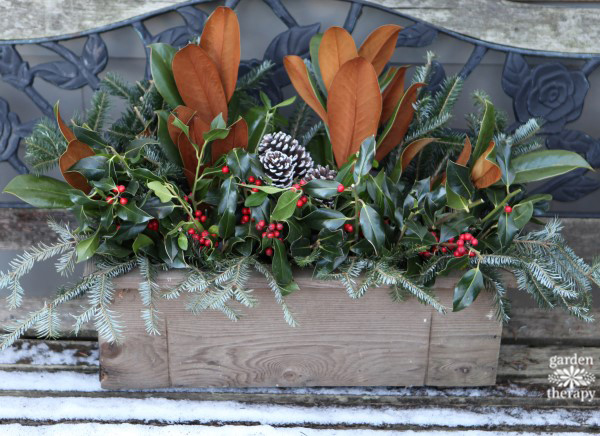
Cedar
Pros: using indoors. It has some of the best longevity, lasting two weeks outside of water indoors and even longer outside.
If you want to make your own garland to use inside, I highly recommend making it out of cedar. This is what I personally use for a garland since I know it will last a while without needing water. You can make it ahead of time and use it to drape across mantles, railings, and porches.
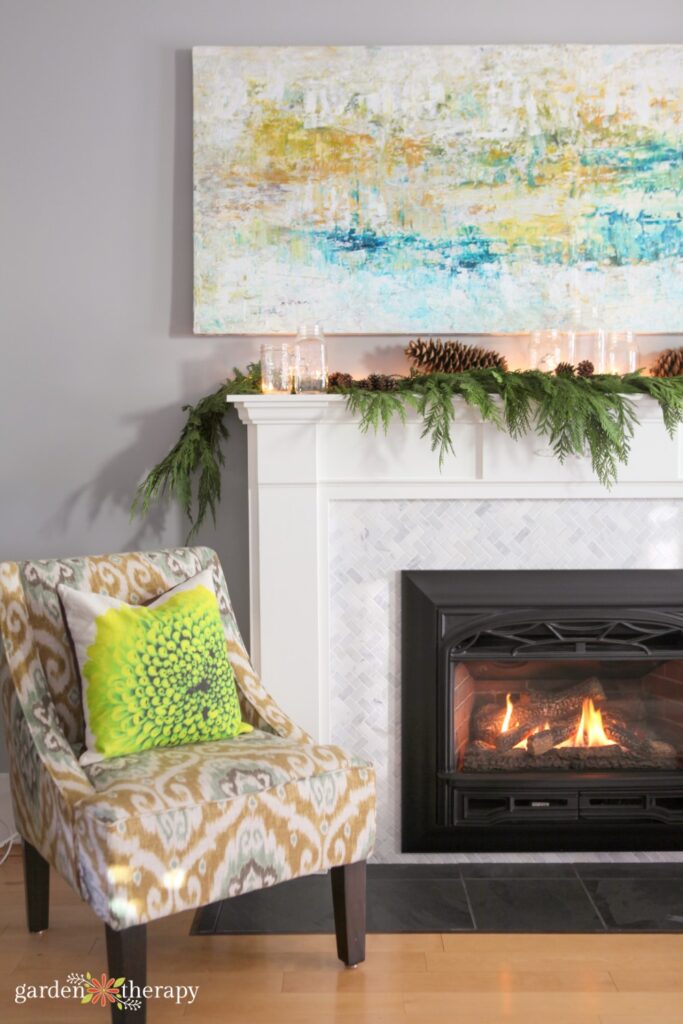
Blue Spruce
Pros: beautiful blue colouring. It works best for outdoor garlands and wreaths as it can dry out quickly inside and drop needles.
You can see how much the blue spruce stands out in this design. Its distinct grey-blue needles offer a nice variety amongst the other fresh Christmas greenery.
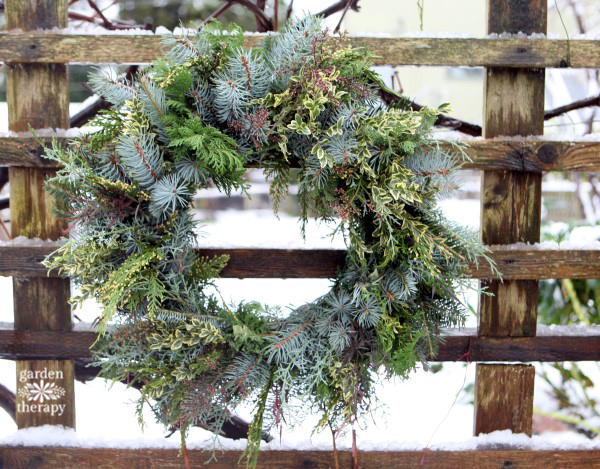
Holly
Pros: beautiful red berries. A Christmas classic, you can make a wreath entirely out of holly or add it along your other arrangements for a pop of red colour.
Holly is another type of greenery I use in many different decorations. Take a look at most of these pictures, and you’ll see the distinct holly berries. You can easily spot the red holly in this wreath featuring 13 different plant varieties, all cut within a 1 km distance from my home.
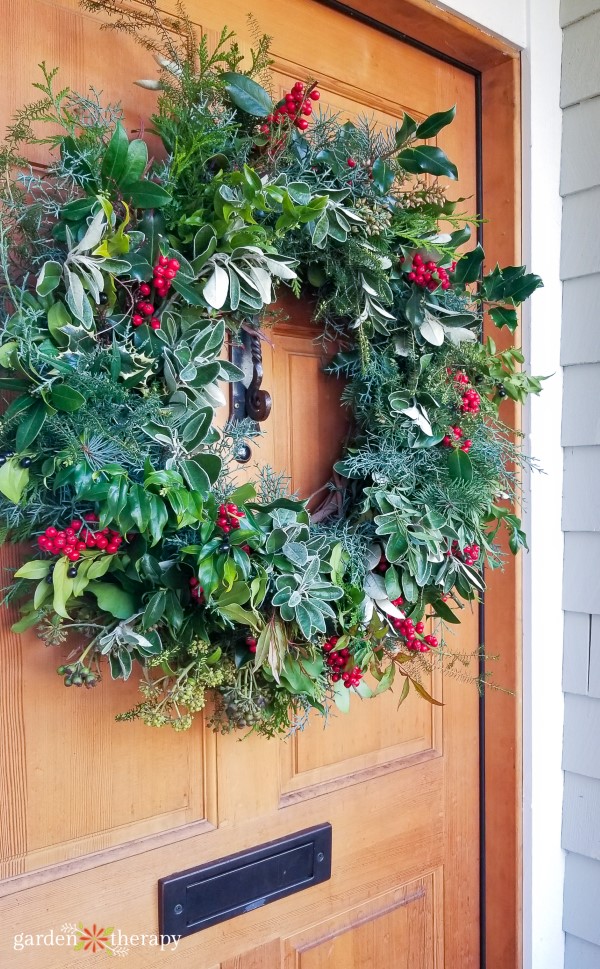
Eucalyptus
Pros: scent. Eucalyptus is one of the best types of greenery to use to add some fragrance. While it doesn’t stay fresh for long, it dries beautifully.
Eucalyptus can really be used year-round. For example, this wreath could stay on the front door well into the new year and not look out of place. I love how sophisticated this aromatherapy wreath looks, featuring silver dollar eucalyptus and incense cedar. You can just imagine how good it smells!
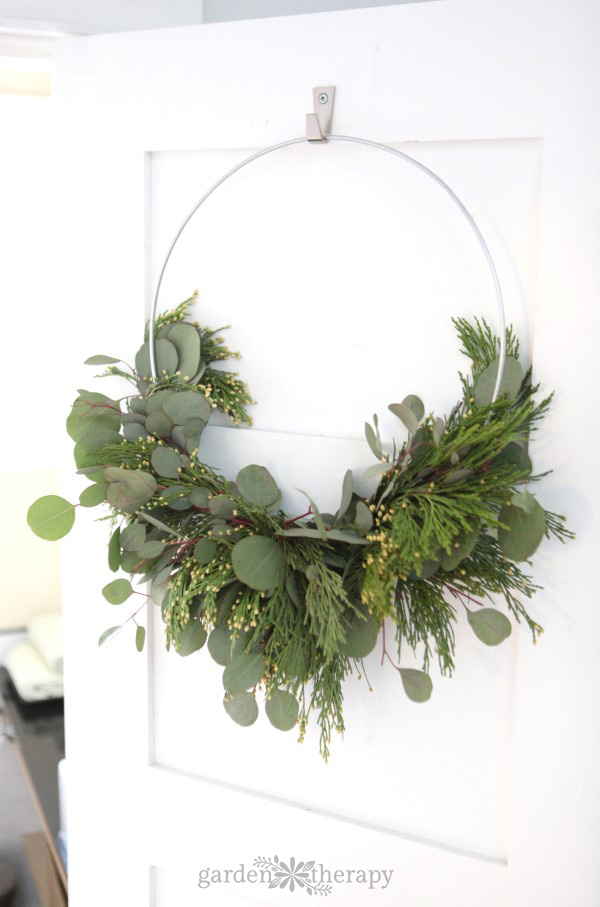
Euonymus
Pros: appearance. I place a lot of euonymus in all kinds of my Christmas greenery because it gives such a unique and beautiful variegation.
In this Christmas candle wreath centrepiece I made, I used euonymus as the bottom layer. You can see how much it stands out and is an unusual but welcome type of Christmas greenery.
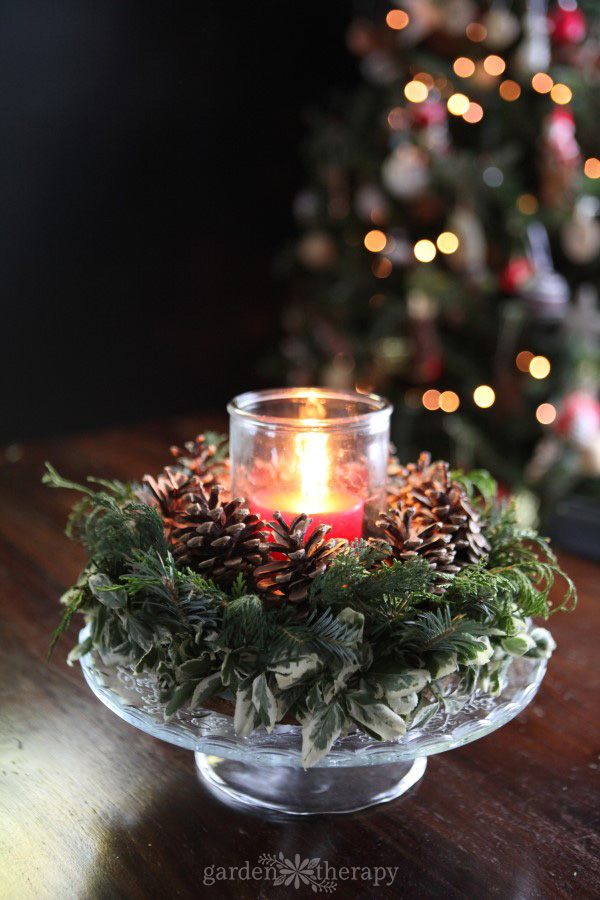
Hydrangea
Pros: variety. I love using dried hydrangea from my garden to add something a little unique to my wreaths.
In this wreath, hydrangea becomes the perfect focal point in the asymmetrical design. When dried properly, they can retain some beautiful watercolour-like colouring. They’re best gathered in the fall when they dry naturally on the branches.
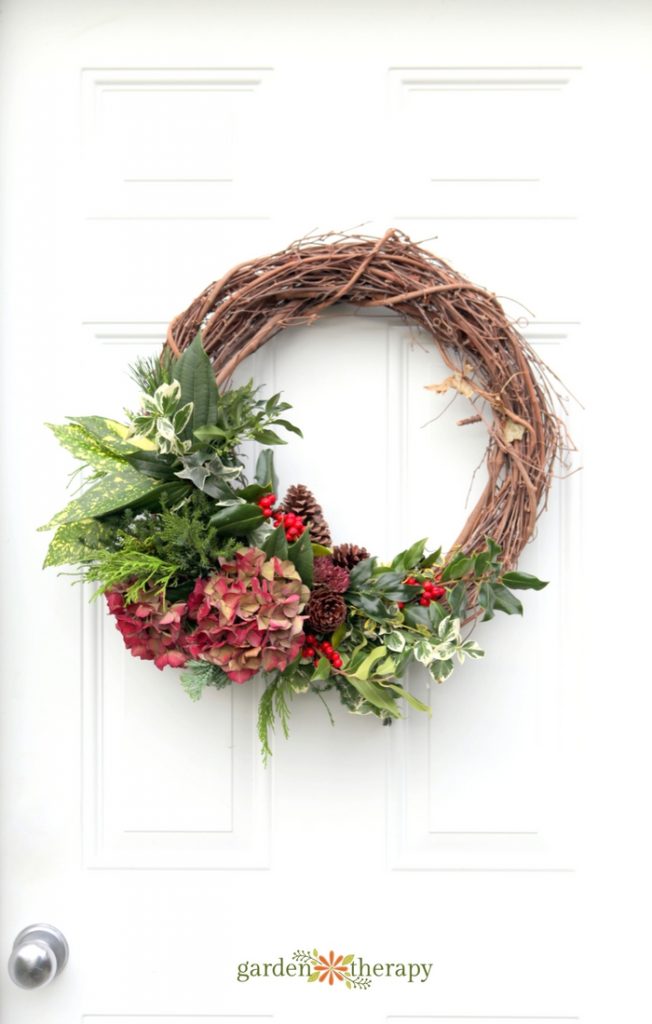
Bay Laurel
Pros: readily available. Bay laurel smells delicious and is another welcome addition to wreaths hung at the front door, where their scent might be enjoyed.
A laurel wreath is one of the original symbols of triumph in ancient Greece. It’s one of the most traditional wreaths you can make! But I like to use it as a filler alongside other greens, like this holly wreath. It blends in beautifully.
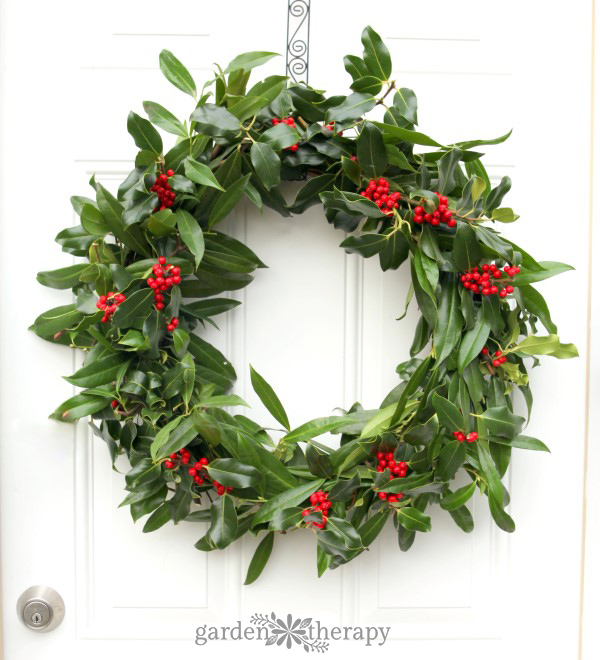
Japanese Aucuba
Pros: appearance. Japanese aucuba has beautiful spotted yellow leaves that give some colour alongside its fresh leaves to wreaths, garlands, and more.
Japanese aucuba is a popular houseplant, but it also grows outside where I live, making it easy for me to find to add as a decorative element to my wreaths and centrepieces.
Can you see the yellow-spotted leaves in this wreath?
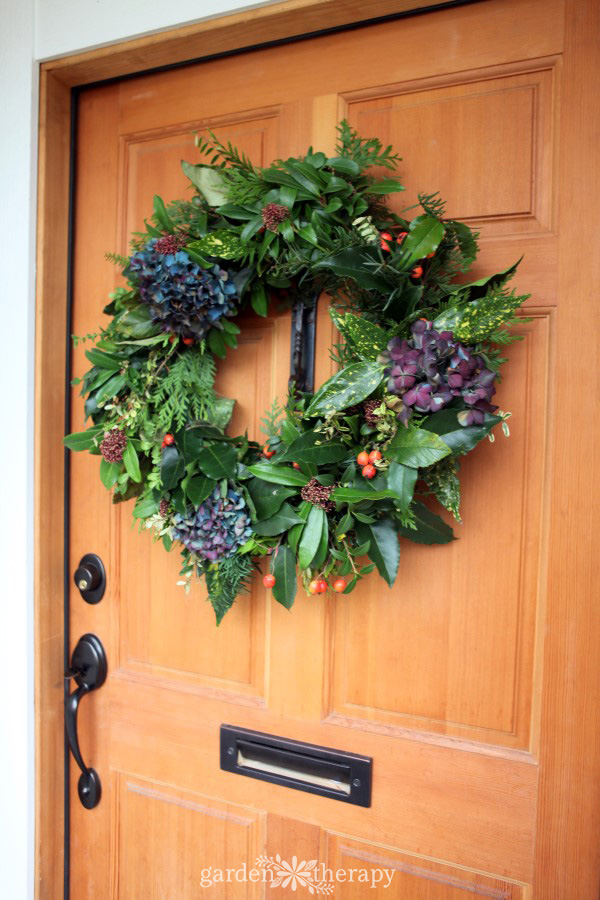
Fraser Fir
Pros: readily available. As one of the most popular types of greenery used for Christmas trees, you can take clippings from your own Christmas tree to use in your décor.
Take a look at how I used Fraser fir at the bottom of this Christmas candle centrepiece. Pointy needles always bring a nice texture to arrangements.

Types of Greenery for Holiday Decorating
As you can probably see by now, Christmas greenery is not limited just to evergreens, and it’s not always green! Some of the most beautiful holiday arrangements include needle and broad-leaf evergreen foliage, perennial flower and seed heads, herbs, and branches.

Conifers
Cut these needle-leaf evergreens from well-established trees/shrubs. The branches should be firm, cool to the touch, and full of green needles. Avoid browning, yellowing, shedding needles, or obvious signs of disease and pest problems.
- Pine
- Fir
- Spruce
- Juniper
- Cedar
- Cypress
- Arborvitae
- Cryptomeria
- Hemlock
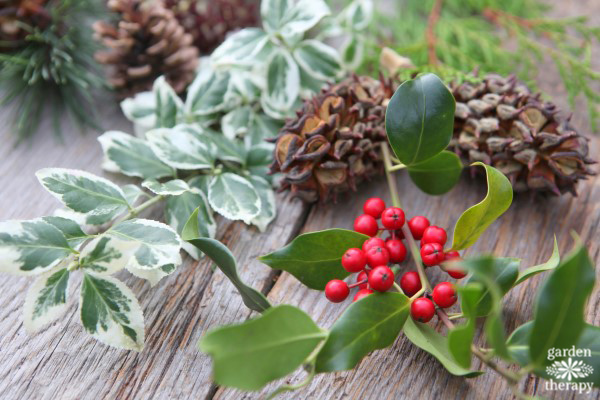
Broad-Leaf Evergreens
Broad-leaf evergreens add a different texture and a whole lot of colour to holiday arrangements. These are some of my favourites.
- Aucuba
- Euonymus
- Bay
- Holly
- Magnolia
- Laurel
- Ligustrum
- Pittosporum
- Viburnum
- Nandina
- Pieris
- Ivy
- Sarcococca
- California Lilac
- Variegated Boxwood
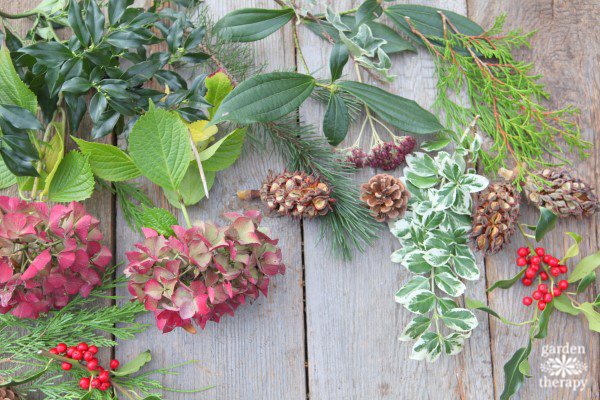
Herbs
Herbs are a fragrant addition to holiday decorating and complement the other elements well.
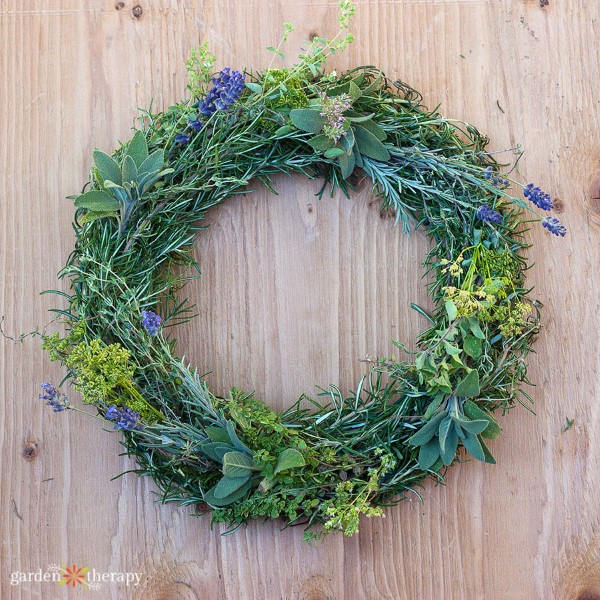
Perennials and Flowers
Perennials that have flowered and dried in the garden can provide beautiful additions to a wreath or garland. When the holiday season comes around, you’ll be happy that you didn’t cut these back!
Dried Flower Heads
- Hydrangea
- Sedum “Autumn Joy”
- English Ivy
- Chinese Lantern Flower
Dried Seed Heads and Pods
- Poppy
- Coneflower
- Nigella
- Luneria
- Eryngium
- Globe Thistle
- Allium
- Daylily
- Magnolia
- Pinecones
- Crocosmia
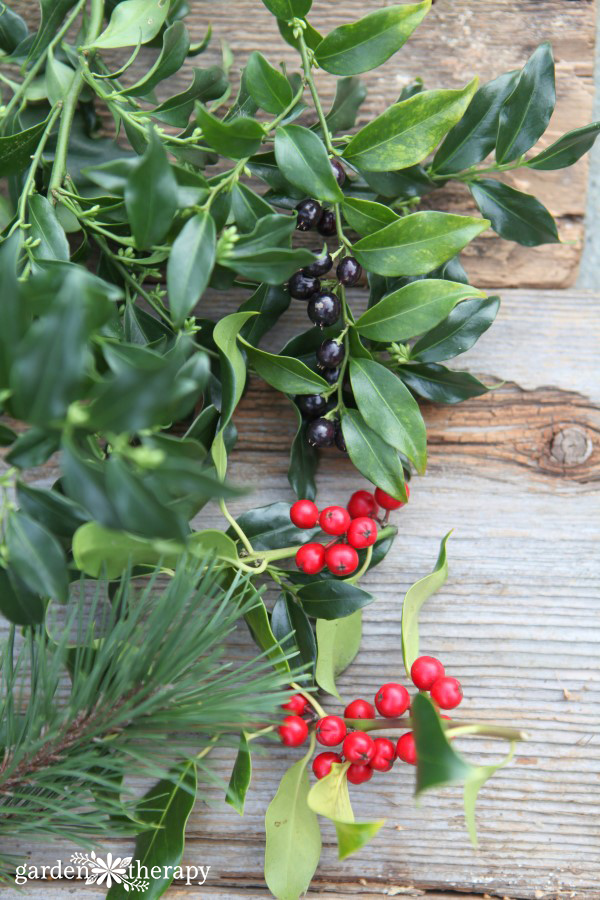
Branches
Any branches that look beautiful in the garden would look lovely in holiday decorating, but a few are extra special.
- Red and Yellow Twig Dogwoods have bright-coloured branches that glow in the landscape as well as in arrangements.
- Curly willows and Harry Lauder’s Walking Stick add festive curled branches.
- Birch is a long-time holiday season favourite. Add sections of birch logs to decorations.
- Branches with colourful berries are worth adding to arrangements. Notably, holly (red), snowberry (white), Cotoneaster (orange and red), and beauty berry (purple) have berries that can’t be beaten.
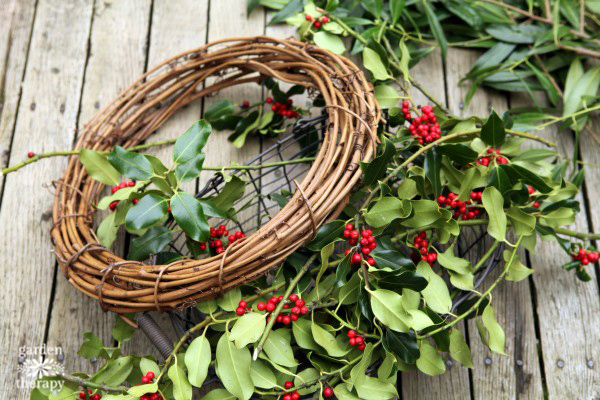
Types of Greenery to Avoid
Some types of garden greenery are best to avoid, as they won’t last long enough to enjoy in arrangements. Yew looks pretty in the garden, but it will shed its leaves within a day, and it’s quite toxic to pets and humans. Best to give yew a pass.
Norway spruce is a popular Christmas tree, but it also sheds needles the fastest.
Boxwood is probably one of the most popular broad-leaf evergreens for decorating with greenery, but I only use the variegated varieties. Many of the common green varieties smell terrible (like cat urine), which isn’t something I want on my door or holiday table.
Finally, be sure to look for greenery that is free from pests and diseases. You can always wash the sturdier cuttings with the garden hose if debris is left over from the growing season.
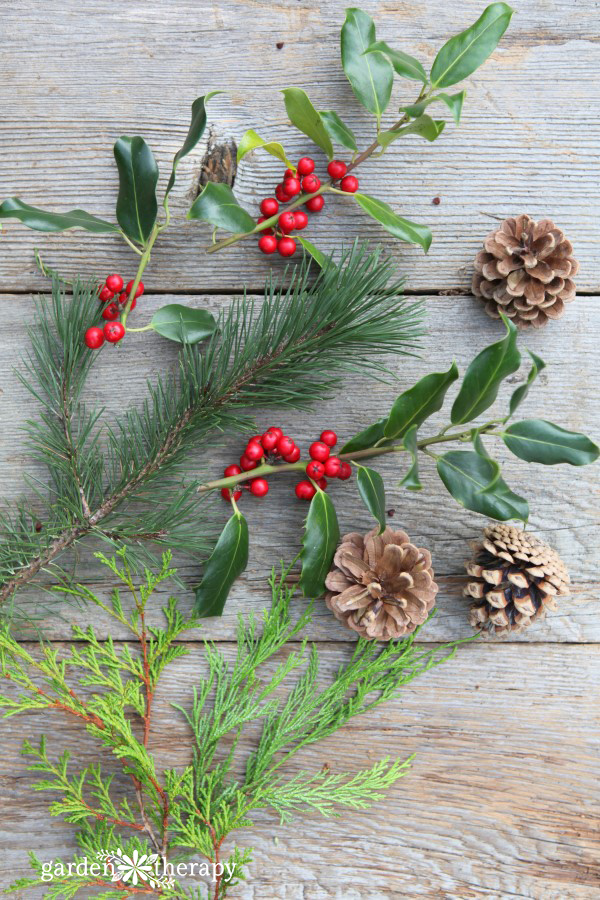
Frequently Asked Questions About Decorating With Christmas Greenery
I encourage you to forage for greenery for Christmas as much as possible! Clip from your own garden and nature areas away from home. Make sure you know which plants are okay to harvest from and avoid anything endangered.
In terms of buying Christmas greenery, stay away from florist shops. While the quality will be excellent, you’ll also pay a pretty penny for it. Look for what’s local to your area, as that’s what will be the most affordable.
Pine, spruce, and cedar are the least expensive for me because they’re plentiful in my area. The rarer it is, the more expensive it will be.
The fresher the ingredients, the longer they’ll last. Before you even begin using your greenery, let the stems absorb as much water as possible beforehand. Make a fresh cut to the stem, then let it sit in water for ideally 24 hours before decorating with greenery.
Once you’ve decorated, you can mist the greenery to keep them hydrated. Mist the back where the stems are so they can drink in some of the moisture.
The cooler the air, the longer greenery will last. This means that Christmas greenery does the best while outside, out of direct sunlight. Inside, keep it away from any heat sources.
If the greenery is small and moveable, consider moving it to a cool place like the fridge, basement, or garage when not in use.
If you properly care for your greenery and it’s fresh, it can last 2+ weeks inside the house. When outdoors, it lasts for much longer. This means you can usually enjoy it well past Christmas!
Cedar, Fraser fir, Douglas fir, balsam fir, Nordman fir, scotch pine, magnolia, and ruscus are all fresh Christmas greenery that lasts a long time without water.
In terms of traditional Christmas greenery, incense cedar, Fraser fir, balsam fir, scotch pine, and eucalyptus are all very fragrant. Also, consider incorporating herbs like rosemary, sage, or lavender if scent is your primary goal.
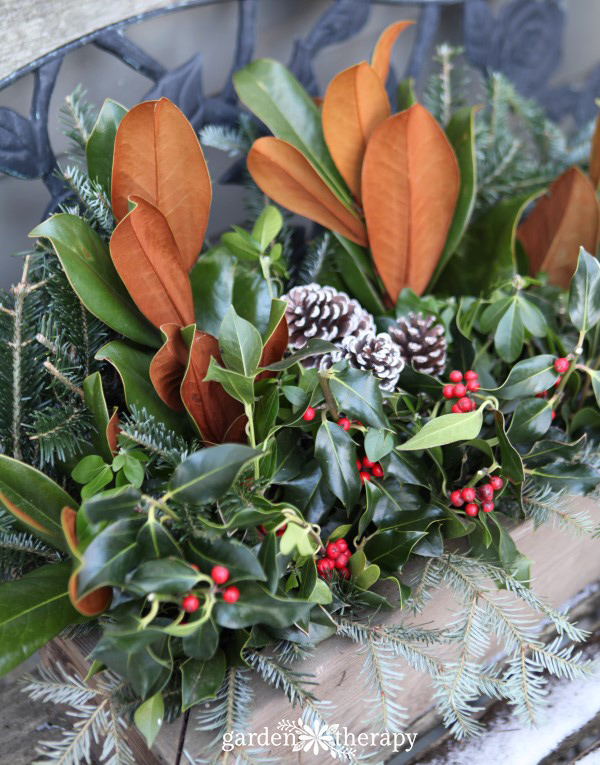
Did I miss any? If you have any Christmas greenery for decorating that you love or avoid, please leave a comment and share your thoughts.
There are so many materials to work with out in the world—especially in differing climates—and I’m always learning new ones that work (and don’t).
How to Use Christmas Greenery
Now that you have all your gorgeous greenery ready, here are a few ways you can use it to create beautiful Christmas decor.




Hi Stephanie i am looking for diy sheets or a book on how to make glass beaded garden stakes and chimes. Are you able to suggest where i can get them from. I am not very art so want some simple instructions to get started. Your help would be very much appreciated
Hi, Stephanie! As usual, a great article. How I miss having access to “wintery” plants this time of year! Here in Brazil, we have pines and such, but they typically look completely different. I usually decorate with bromeliads and other plants that you have as houseplants! In fact, I’m in the process of writing a post about festive tropical plants to use as holiday decor… should be on my blog by Monday, Dec. 12!
Hi Stephanie,
I picked a few buckets full of rose hips this fall. Some are in glycerin and some just straight water. Do you have any experience with rose hips in wreaths? I appreciate all your tips and ideas. You are so inspiring!
Rhonda
Hi Rhonda, great suggestion! Rosehips look lovely in wreaths and will dry naturally over a few months. They will start to wrinkle and turn colour, but last long enough that you can enjoy them in seasonal wreaths. I haven’t used glycerin to preserve them so I can’t speak to that. But with all my wreaths, I try to use the longest lasting natural elements and then just toss them in the compost after the wreath stops looking so great. In many cases, I’m tossing it in the bin in spring just because I’m ready for a refresh but the wreath still looks gorgeous!
We’ve enjoyed using the Osage oranges (the ones that are large, lime green, and wart covered). Spray painted, put on a plant stick and put it with other greens and tall grasses in a big outdoor planter. We have used them for street planters in a nearby village.
Help. This might be out of your realm.
The bluish grayish berries on a holiday wreath that grow on a lighter green foliage.
The question is are they poisonous to dogs you may not be a vet but it might be helpful in this instance she is a small dog she only consumed one little blue berry in thinking it was part of her cookie.
I don’t see it amongst the top Christmas plant foliage that is dangerous to dogs.
Yellow-green foliage
Call the vet please. It’s best to get help immediately from a professional if you think your dog may be posioned.